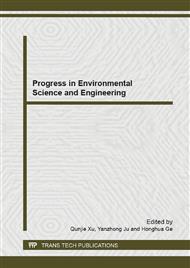p.1305
p.1309
p.1315
p.1321
p.1328
p.1333
p.1338
p.1343
p.1349
Comparison and Selection of Different Medium on the Effect of Improving Soil Deodorization
Abstract:
Based on the investigation of odor concentration of retention tank in combined system, it aim at the removal of mixed odor and pressure drop with blast furnace slag, pebble, sand as improved medium and soil as contrast through mixed odor of ammonia gas and hydrogen sulfide made in lab-scale. The results showed that the removal rate of H2S by different medium packed column becomes stable after 12 days, and 35 days for NH3. Pressure drop of each column meets with Equation Ergum and under the same condition the order is as follows: soil>sand>pebble>blast furnace slag. And the removal rate of each medium is: soil>sand>blast furnace slag. The soil is good for removal but its pressure drop is so high that it limits flow charge, thus its removal rate is the lowest. As a result, sand and pebble as the medium for soil deodorization considering pressure drop and the effect of deodorization were chosen. It turns out that the removal rate of NH3 is higher than 65% while H2S higher than 98%.
Info:
Periodical:
Pages:
1328-1332
Citation:
Online since:
December 2012
Authors:
Keywords:
Price:
Сopyright:
© 2013 Trans Tech Publications Ltd. All Rights Reserved
Share:
Citation:


